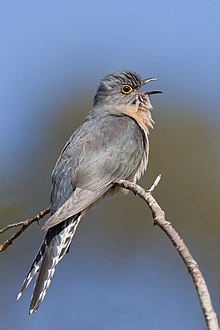| Cuckoos | |
|---|---|

| |
| Fan-tailed cuckoo (Cacomantis flabelliformis) | |
| Scientific classification | |
| Domain: | Eukaryota |
| Kingdom: | Animalia |
| Phylum: | Chordata |
| Class: | Aves |
| Clade: | Otidimorphae |
| Order: | Cuculiformes Wagler, 1830 |
| Family: | Cuculidae Leach, 1819 |
| Type genus | |
| Cuculus | |
| Genera | |
|
33 genera, see text | |
Cuckoos are birds in the Cuculidae (/kjuːˈkjuːlɪdiː/ kew-KEW-lih-dee) family, the sole taxon in the order Cuculiformes (/kjuːˈkjuːlɪfɔːrmiːz/ kew-KEW-lih-for-meez).[1][2][3] The cuckoo family includes the common or European cuckoo, roadrunners, koels, malkohas, couas, coucals, and anis. The coucals and anis are sometimes separated as distinct families, the Centropodidae and Crotophagidae, respectively. The cuckoo order Cuculiformes is one of three that make up the Otidimorphae, the other two being the turacos and the bustards. The family Cuculidae contains 150 species, which are divided into 33 genera.
The cuckoos are generally medium-sized, slender birds. Most species live in trees, though a sizeable minority are ground-dwelling. The family has a cosmopolitan distribution; the majority of species are tropical. Some species are migratory. The cuckoos feed on insects, insect larvae, and a variety of other animals, as well as fruit. Some species are brood parasites, laying their eggs in the nests of other species and giving rise to the metaphor "cuckoo's egg", but most species raise their own young.
Cuckoos have played a role in human culture for thousands of years, appearing in Greek mythology as sacred to the goddess Hera. In Europe, the cuckoo is associated with spring, and with cuckoldry, for example in Shakespeare's Love's Labour's Lost. In India, cuckoos are sacred to Kamadeva, the god of desire and longing, whereas in Japan, the cuckoo symbolises unrequited love.
- ^ Ericson, P.G.P.; et al. (2006). "Diversification of Neoaves: integration of molecular sequence data and fossils" (PDF). Biology Letters. 2 (4): 543–547. doi:10.1098/rsbl.2006.0523. PMC 1834003. PMID 17148284. Archived from the original (PDF) on 2008-03-07.
- ^ Hackett, S.J.; et al. (2008). "A Phylogenomic Study of Birds Reveals Their Evolutionary History". Science. 320 (5884): 1763–1768. Bibcode:2008Sci...320.1763H. doi:10.1126/science.1157704. PMID 18583609. S2CID 6472805.
- ^ Jarvis, E.D.; et al. (2014). "Whole-genome analyses resolve early branches in the tree of life of modern birds". Science. 346 (6215): 1320–1331. Bibcode:2014Sci...346.1320J. doi:10.1126/science.1253451. PMC 4405904. PMID 25504713.